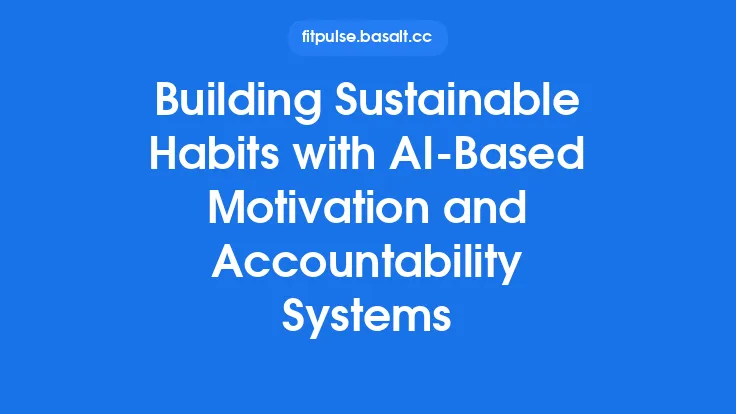Calisthenics is more than a series of impressive pull‑ups or handstand holds; it is a lifestyle that thrives on consistency, adaptability, and respect for both the body and the environment. While technique and programming often dominate the conversation, the underlying habits that sustain progress are equally vital. Below is a deep dive into the evergreen lifestyle practices that, when adopted deliberately, create a fertile ground for continual calisthenic development.
Embracing Periodization for Long‑Term Gains
A well‑structured periodization plan transforms the chaotic “do‑more‑every‑day” mindset into a science‑backed roadmap. By cycling through distinct training phases, you protect joints, avoid plateaus, and ensure that each skill receives the appropriate stimulus.
| Phase | Primary Goal | Typical Intensity (RPE) | Volume Range | Example Focus |
|---|---|---|---|---|
| Accumulation | Build foundational strength & endurance | 6‑7 | High (4‑6 sets × 8‑12 reps) | Assisted pull‑ups, basic push‑up variations |
| Intensification | Increase load & skill difficulty | 8‑9 | Moderate (3‑5 sets × 4‑8 reps) | Weighted dips, strict muscle‑ups progressions |
| Realization | Peak performance & skill execution | 9‑10 | Low (2‑4 sets × 1‑3 reps) | Full handstand push‑ups, one‑arm pull‑ups |
| Deload/Recovery | Consolidate adaptations, reduce fatigue | 4‑5 | Very low (1‑2 sets × 3‑5 reps) | Light mobility circuits, bodyweight flow |
Key practices for sustainable periodization:
- Macro‑cycle planning: Map out a 6‑12‑month horizon, aligning major skill milestones (e.g., achieving a full planche) with realistic timelines.
- Micro‑cycle flexibility: Allow a 10‑15 % variance week‑to‑week to accommodate life events without derailing the overall plan.
- Auto‑regulation: Use Rate of Perceived Exertion (RPE) or Velocity‑Based Training (VBT) tools (e.g., a simple stopwatch for movement tempo) to adjust load on the fly.
Data‑Driven Progress Tracking
Numbers do not replace intuition, but they provide an objective lens through which you can gauge true progress. A minimal yet powerful tracking system includes:
- Movement Log – Record each session’s exercise, sets, reps, and any assistance (bands, weight vests).
- Performance Metrics – Track maximal reps, hold times, and skill completions (e.g., “30‑second L‑sit”).
- Load Quantification – Convert bodyweight plus external load into a single “effective load” figure:
\[
\text{Effective Load} = \text{Bodyweight} + \text{External Load} - \text{Assistance}
\]
This enables direct comparison across assisted vs. weighted variations.
- Rate of Progress – Calculate weekly or monthly percentage changes to spot diminishing returns early.
Visualization tools (spreadsheets, simple apps, or even a wall‑mounted chart) keep the data in sight, reinforcing the habit of reflection and adjustment.
Sustainable Training Environments
Choosing where you train can dramatically affect both performance and ecological footprint.
- Public Parks & Urban Structures – Leveraging existing bars, railings, and playground equipment eliminates the need for personal hardware while exposing you to varied grip widths and angles, fostering well‑rounded strength.
- Natural Terrain – Training on sand, grass, or low‑lying rocks introduces instability that enhances proprioception and joint stability—key for advanced calisthenic moves.
- Seasonal Adaptation – Adjust your environment with the climate: use indoor climbing gyms during extreme heat, or early‑morning sessions in summer to avoid heat stress.
By rotating locations, you also prevent overuse injuries associated with repetitive stress on identical surfaces.
Integrating Functional Movement into Everyday Life
Beyond dedicated sessions, embedding functional movement patterns into daily activities creates a “movement‑rich” lifestyle.
- Staircase Utilization – Replace elevators with stair climbs, focusing on controlled descent to develop eccentric strength in the quadriceps and glutes.
- Doorway Rows – When a sturdy door is available, perform inverted rows while waiting for the kettle to boil or during short breaks.
- Dynamic Loading – Carry groceries or a backpack using a “ruck” approach, progressively adding weight to simulate weighted calisthenic drills.
These micro‑habits increase total weekly volume without demanding extra time blocks, reinforcing the principle of “movement as a habit, not a chore.”
Eco‑Conscious Equipment Choices
Sustainability extends to the gear you use. Opt for equipment that minimizes waste and maximizes longevity.
- Natural Fiber Resistance Bands – Made from latex or recycled rubber, they degrade less quickly than synthetic alternatives.
- Portable Parallettes from Recycled Materials – Look for models constructed from reclaimed aluminum or bamboo composites.
- Reusable Chalk Alternatives – Mineral‑based chalk powders can be stored in refillable containers, reducing single‑use packaging.
When purchasing, prioritize manufacturers with transparent supply chains and repair‑friendly designs, ensuring your tools serve you for years rather than becoming landfill.
Breathwork and Neuromuscular Efficiency
Efficient breathing is a cornerstone of strength expression, yet it often receives less attention than it deserves.
- Diaphragmatic Activation – Prior to heavy pulling or pushing, practice a three‑second diaphragmatic inhale followed by a controlled exhale timed with the concentric phase. This stabilizes the core and improves intra‑abdominal pressure.
- Box Breathing for Skill Execution – For static holds (e.g., front lever), adopt a 4‑4‑4‑4 pattern (inhale‑hold‑exhale‑hold) to maintain tension without premature fatigue.
- Pursed‑Lips Exhalation – During eccentric phases, exhaling through pursed lips slows the descent, enhancing muscle control and reducing joint impact.
Incorporating a brief breathwork routine at the start of each session trains the nervous system to synchronize respiration with movement, yielding smoother, more powerful repetitions.
Habitual Mobility and Flexibility Maintenance
Mobility is the silent engine behind calisthenic proficiency. A sustainable approach treats it as a daily micro‑practice rather than a weekly “stretch day.”
- Joint‑Specific Warm‑Ups – Perform 2‑3 minutes of scapular push‑ups, wrist circles, and ankle dorsiflexion drills before every workout.
- Dynamic Stretch Sequences – Integrate leg swings, arm circles, and hip openers into the transition periods between sets.
- Post‑Session Myofascial Release – Use a compact foam roller or a lacrosse ball for 30‑second sweeps over tight zones (e.g., thoracic spine, lats).
Consistency in these micro‑mobility habits preserves range of motion, reduces injury risk, and accelerates skill acquisition.
Lifestyle Alignment: Circadian Rhythm Awareness
While sleep itself is a distinct topic, aligning training times with your natural circadian peaks can amplify performance without altering sleep quantity.
- Morning Hormonal Surge – Testosterone and cortisol levels are naturally higher in the early hours; scheduling strength‑focused sessions (pull‑ups, dips) during this window can enhance power output.
- Afternoon Flexibility Window – Body temperature peaks mid‑afternoon, making it an optimal period for demanding skill work (handstand progressions, planche leans).
Tracking your perceived energy levels across the day and adjusting session timing accordingly creates a subtle yet powerful synergy between biology and training.
Continuous Learning and Skill Acquisition
The calisthenic journey is a perpetual learning curve. Embedding knowledge‑seeking habits ensures that progress remains sustainable.
- Micro‑Study Sessions – Dedicate 10‑15 minutes after each workout to read a technique article, watch a tutorial, or analyze a movement video.
- Skill Journaling – Document not only numbers but also qualitative observations (“felt tight in shoulders during L‑sit”). Over time, patterns emerge that guide corrective work.
- Cross‑Disciplinary Exploration – Occasionally study biomechanics, kinesiology, or sports psychology to deepen your understanding of movement mechanics.
These intellectual habits keep motivation high and prevent stagnation, as each new insight can be directly applied to the next training block.
Closing Thoughts
Sustainable progress in calisthenics is the product of a holistic lifestyle that intertwines structured programming, data‑driven reflection, environmentally mindful choices, and daily micro‑habits. By deliberately cultivating the practices outlined above—periodized training, meticulous tracking, adaptable environments, functional movement integration, eco‑conscious equipment, breath‑focused neuromuscular control, consistent mobility work, circadian‑aligned session timing, and a commitment to continuous learning—you create a resilient foundation. This foundation not only supports the physical feats you aim to achieve but also ensures that your calisthenic journey remains enjoyable, adaptable, and enduring for years to come.




